Complex AC Magnetic Susceptibility as a Tool for Exploring Nonlinear Magnetic Phenomena and Pinning Properties in Superconductors
Abstract
1. Introduction
2. Materials and Methods
3. Results and Discussion
4. Conclusions
- The unusual detection of second order harmonic components, even without a superimposed DC field. We have discussed that the origin of generation, as a mark of asymmetricity in the AC magnetization cycle, is possibly related to the presence of both dynamic and static magnetization intrinsic profiles due to the dual superconducting/magnetic nature and structural complexity of the crystal;
- The comparative analysis of the fundamental and third harmonic components revealed a temperature divergence in the activity of the linear/nonlinear vortex dynamics (without a superimposed DC field). Similarly, as for the second harmonic, this also can be related to the indirect influence of the intrinsic magnetic order.
Author Contributions
Funding
Data Availability Statement
Conflicts of Interest
References
- Gömöry, F. Characterization of high-temperature superconductors by AC susceptibility measurements. Supercond. Sci. Technol. 1997, 10, 523–542. [Google Scholar] [CrossRef]
- Francavilla, T.L.; Hein, R.A.L. Magnetic Susceptibility of Superconductors and Other Spin Systems; Springer: Berlin/Heidelberg, Germany, 1991; ISBN 0306441977. [Google Scholar]
- Ishida, T.; Goldfarb, R. Fundamental and harmonic susceptibilities of YBa2Cu3O7-δ. Phys. Rev. B 1990, 41, 8937–8948. [Google Scholar] [CrossRef]
- Zola, D.; Gömöry, F.; Polichetti, M.; Strýček, F.; Seiler, E.; Hušek, I.; Kováč, P.; Pace, S. A study of coupling loss on bi-columnar BSCCO/Ag tapes through ac susceptibilitymeasurements. Supercond. Sci. Technol. 2004, 17, 501. [Google Scholar] [CrossRef]
- Ozogul, O.; Aydinuraz, A. Characterization of high- T c superconductors using the higher-harmonic susceptibility. Supercond. Sci. Technol. 2001, 14, 184–189. [Google Scholar] [CrossRef]
- Qin, M.; Yao, X. AC susceptibility of high-temperature superconductors. Phys. Rev. B 1996, 54, 7536–7544. [Google Scholar] [CrossRef]
- Qin, M.; Ong, C. Frequency dependence of harmonic susceptibilities in high-temperature superconductors. Phys. Rev. B 2000, 61, 9786–9792. [Google Scholar] [CrossRef]
- Qin, M.J.; Ong, C.K. Third harmonic ac susceptibility of superconducting strips and disks. Phys. C Supercond. 2000, 334, 107–114. [Google Scholar] [CrossRef]
- Qin, M.; Ong, C. Studies on the scaling of fundamental AC susceptibility in high temperature superconductors. Phys. C Supercond. 2000, 331, 18–24. [Google Scholar] [CrossRef]
- Ito, H.; Hayano, H.; Kubo, T.; Saeki, T. Vortex penetration field measurement system based on third-harmonic method for superconducting RF materials. Nucl. Instrum. Methods Phys. Res. Sect. A Accel. Spectrometers Detect. Assoc. Equip. 2020, 955, 163284. [Google Scholar] [CrossRef]
- Qin, M.J.; Ong, C.K. Studies on AC susceptibility of superconductors with finite thickness. Phys. C Supercond. 1999, 325, 173–180. [Google Scholar] [CrossRef]
- Polichetti, M.; Adesso, M.G.; Pace, S. Third harmonics of the AC magnetic susceptibility: A method for the study of flux dynamics in high temperature superconductors. Eur. Phys. J. B-Condens. Matter. 2003, 36, 27–36. [Google Scholar] [CrossRef]
- Di Gioacchino, D.; Celani, F.; Tripodi, P.; Testa, A.; Pace, S. Nonuniversal temperature dependencies of the low-frequency ac magnetic susceptibility in high-Tc superconductors. Phys. Rev. B 1999, 59, 11539–11550. [Google Scholar] [CrossRef]
- Adesso, M.G.; Senatore, C.; Polichetti, M.; Pace, S. Harmonics of the AC susceptibility as probes to differentiate the various creep models. Phys. C Supercond. 2004, 404, 289–292. [Google Scholar] [CrossRef]
- Adesso, M.G.; Polichetti, M.; Pace, S. A new method to detect the vortex glass phase and its evidence in YBCO. J. Phys. Condens. Matter 2008, 20, 385211. [Google Scholar] [CrossRef]
- van der Beek, C.; Geshkenbein, V.; Vinokur, V. Linear and nonlinear ac response in the superconducting mixed state. Phys. Rev. B 1993, 48, 3393–3403. [Google Scholar] [CrossRef]
- Gencer, A. Harmonic susceptibilities of a bulk superconductor MgB2 at low magnetic fields. Supercond. Sci. Technol. 2002, 15, 247–253. [Google Scholar] [CrossRef]
- Aksu, E.; Gencer, A.; Yılmaz, H.; Nezir, S. Fundamental and high-order harmonic susceptibilities of a BSCCO(2223) bulk superconductor. Phys. C Supercond. 2003, 391, 67–74. [Google Scholar] [CrossRef]
- Nikolo, M. Numerical modeling of AC susceptibility and induced nonlinear voltage waveforms of high-Tc granular superconductors. AIP Conf. Proc. 2018, 2025, 050004. [Google Scholar] [CrossRef]
- Qin, M.J.; Ong, C.K. AC susceptibility of superconductors with geometric barrier. Phys. C Supercond. 2000, 341–348, 1095–1096. [Google Scholar] [CrossRef]
- Shantsev, D.; Galperin, Y.; Johansen, T. Thin superconducting disk with field-dependent critical current: Magnetization and ac susceptibilities. Phys. Rev. B 2000, 61, 9699–9706. [Google Scholar] [CrossRef]
- Maksimova, G.; Vodolazov, D.; Maksimov, I. Magnetization curves and ac susceptibilities in type-II superconductors: Geometry-independent similarity and effect of irreversibility mechanisms. Phys. C Supercond. 2001, 356, 67–82. [Google Scholar] [CrossRef]
- Xu, X.B.; Zhang, L.; Leng, X.; Ding, S.Y.; Liu, H.K.; Wang, X.L.; Dou, S.X.; Lin, Z.W.; Zhu, J.G. Third harmonics due to surface barrier in high-temperature superconductor. J. Appl. Phys. 2005, 97, 10B105. [Google Scholar] [CrossRef]
- Chen, D.X.; Sanchez, A.; Hernando, A. Magnetic dynamic hysteresis of a resistively shunted Josephson-junction array. Phys. Rev. B 1994, 50, 10342. [Google Scholar] [CrossRef]
- Motta, M.; Colauto, F.; Johansen, T.H.; Dinner, R.B.; Blamire, M.G.; Ataklti, G.W.; Moshchalkov, V.V.; Silhanek, A.V.; Ortiz, W.A. Flux avalanches triggered by AC magnetic fields in superconducting thin films. Phys. C Supercond. 2012, 479, 134–136. [Google Scholar] [CrossRef]
- Fukumoto, Y.; Kiuchi, M.; Otabe, E.S.; Matsushita, T.; Sawa, H.; Inoue, M.; Kiss, T.; Iijima, Y.; Kakimoto, K.; Saitoh, T. Evaluation of E–J characteristics of YBCO coated-conductor by AC inductive method using third-harmonic voltage. Phys. C Supercond. 2004, 412–414, 1036–1040. [Google Scholar] [CrossRef]
- Gilchrist, J.; Dombre, T. Flux creep and harmonic generation. Phys. Rev. B 1994, 49, 1466–1469. [Google Scholar] [CrossRef]
- Crisan, A.; Iyo, A.; Kito, H.; Tanaka, Y.; Hirai, M.; Sasase, M.; Okayasu, S.; Ihara, H. AC susceptibility and higher harmonics studies of heavy-ion irradiated CuBa2Ca3Cu4Oy bulk superconductor with highest irreversibility field above liquid-nitrogen temperature. Phys. C Supercond. 2002, 378–381, 112–117. [Google Scholar] [CrossRef]
- Cardwell, D.A.; Larbalestier, D.C.; Braginski, A.I. Handbook of Superconductivity; Academic Press: Cambridge, MA, USA, 2022. [Google Scholar] [CrossRef]
- Adesso, M.G.; Polichetti, M.; Pace, S. Harmonics of the AC susceptibility for the study of I–V curves in melt grown YBCO. Phys. C Supercond. 2004, 401, 196–200. [Google Scholar] [CrossRef]
- Nikolo, M.; Goldfarb, R.B. Flux creep and activation energies at the grain boundaries of Y-Ba-Cu-O superconductors. Phys. Rev. B 1989, 39, 6615–6618. [Google Scholar] [CrossRef]
- Zhang, L.; Ding, S.Y.; Liu, G.H.; Li, P.; Tang, Z.; Li, Y.B.; Huang, K.; Zhu, X.B.; Sun, Y.P. Influence of different pinning ability on harmonic susceptibilities in high-temperature superconductors. Phys. C Supercond. 2012, 475, 38–42. [Google Scholar] [CrossRef]
- Can, H.; Topal, U. Design of Ring Core Fluxgate Magnetometer as Attitude Control Sensor for Low and High Orbit Satellites. J. Supercond. Nov. Magn. 2015, 28, 1093–1096. [Google Scholar] [CrossRef]
- Ge, J.; Gutierrez, J.; Li, J.; Yuan, J.; Wang, H.-B.; Yamaura, K.; Takayama-Muromachi, E.; Moshchalkov, V.V. Dependence of the flux-creep activation energy on current density and magnetic field for a Ca10(Pt3As8)[(Fe1−xPtx)2As2]5 single crystal. Appl. Phys. Lett. 2014, 104, 112603. [Google Scholar] [CrossRef]
- Galluzzi, A.; Buchkov, K.; Tomov, V.; Nazarova, E.; Leo, A.; Grimaldi, G.; Pace, S.; Polichetti, M. Mixed state properties analysis in AC magnetic field of strong pinning Fe(Se,Te) single crystal. Supercond. Sci. Technol. 2020, 33, 094006. [Google Scholar] [CrossRef]
- Nikolo, M.; Zapf, V.S.; Singleton, J.; Jiang, J.; Weiss, J.D.; Hellstrom, E.E. Vortex Flux Dynamics and Harmonic ac Magnetic Response of Ba(Fe0.94Ni0.06)2As2 Bulk Superconductor. J. Supercond. Nov. Magn. 2016, 29, 2745–2752. [Google Scholar] [CrossRef]
- Buchkov, K.; Polichetti, M.; Nenkov, K.; Nazarova, E.; Mancusi, D.; Balchev, N.; Kovacheva, D.; Zahariev, A.; Pace, S. Investigation of the vortex dynamics of Fe1.02Se crystals by fundamental and 3rd harmonic ac magnetic susceptibility analysis. Supercond. Sci. Technol. 2015, 28, 035009. [Google Scholar] [CrossRef]
- Hsu, F.-C.; Luo, J.-Y.; Yeh, K.-W.; Chen, T.-K.; Huang, T.-W.; Wu, P.M.; Lee, Y.-C.; Huang, Y.-L.; Chu, Y.-Y.; Yan, D.-C.; et al. Superconductivity in the PbO-type structure alpha-FeSe. Proc. Natl. Acad. Sci. USA 2008, 105, 14262–14264. [Google Scholar] [CrossRef]
- Amigo, M.L.; Crivillero, V.A.; Franco, D.G.; Badia-Majos, A.; Guimpel, J.; Nieva, G. Vortex pinning by intrinsic correlated defects in Fe1-y Se. J. Phys. Conf. Ser. 2014, 507, 012001. [Google Scholar] [CrossRef]
- Physical Property Measurement System. AC Measurement System (ACMS) Option User ’s Manual; Quantum Design: San Diego, CA, USA, 2003. [Google Scholar]
- Rysak, A.; Korczak, S.Z. Vector description of nonlinear magnetization. J. Magn. Magn. Mater. 2001, 231, 323–330. [Google Scholar] [CrossRef]
- Amigo, M.; Ale Crivillero, M.; Franco, D.; Badia-Majos, A.; Guimpel, J.; Campo, J.; Damay, F.; Porcher, F.; Condo, A.; Nieva, G. Intrinsic pinning by naturally occurring correlated defects in FeSe1-xTex superconductors. Supercond. Sci. Technol. 2017, 30, 085010. [Google Scholar] [CrossRef]
- Askerzade, I. Unconventional Superconductors; Springer: Berlin/Heidelberg, Germany, 2012; Volume 153. [Google Scholar] [CrossRef]
- Brandt, E.H. The flux-line lattice in superconductors. Rep. Prog. Phys. 1995, 58, 1465–1594. [Google Scholar] [CrossRef]
- Gurevich, A. Iron-based superconductors at high magnetic fields. Rep. Prog. Phys. 2011, 74, 124501. [Google Scholar] [CrossRef]
- Lei, H.; Wang, K.; Hu, R.; Ryu, H.; Abeykoon, M.; Bozin, E.S.; Petrovic, C. Iron chalcogenide superconductors at high magnetic fields. Sci. Technol. Adv. Mater. 2012, 13, 054305. [Google Scholar] [CrossRef] [PubMed]
- Ghigo, G.; Fracasso, M.; Gerbaldo, R.; Gozzelino, L.; Laviano, F.; Napolitano, A.; Cao, G.H.; Graf, M.J.; Prozorov, R.; Tamegai, T.; et al. High-Frequency ac Susceptibility of Iron-Based Superconductors. Materials 2022, 15, 1079. [Google Scholar] [CrossRef]
- Di Gioacchino, D.; Tripodi, P.; Celani, F.; Testa, A.M.; Pace, S. Frequency dependence of HTS AC harmonic susceptibility in the Kim-Anderson and collective pinning vortex glass models. IEEE Trans. Appiled Supercond. 2001, 11, 3924–3927. [Google Scholar] [CrossRef]
- Shatz, S.; Shaulov, A.; Yeshurun, Y. Universal behavior of harmonic susceptibilities in type-II superconductors. Phys. Rev. B 1993, 48, 13871–13880. [Google Scholar] [CrossRef] [PubMed]
- Senatore, C.; Polichetti, M.; Zola, D.; Di Matteo, T.; Giunchi, G.; Pace, S. Vortex dynamics and pinning properties analysis of MgB 2 bulk samples by ac susceptibility measurements. Supercond. Sci. Technol. 2003, 16, 183–187. [Google Scholar] [CrossRef]
- Qin, M.J.; Ong, C.K. Harmonic ac susceptibilities of high temperature superconductors. Phys. C Supercond. 1999, 319, 41–49. [Google Scholar] [CrossRef]
- Gencer, A.; Güçlü, N.; Yilmaz, H.; Kiliç, A.; Askerzade, I.N.; Aksu, E.; Hascicek, Y.S. Investigations of even-order harmonic susceptibilities of MgB2 superconductors using critical state approach. IEEE Trans. Appl. Supercond. 2003, 13, 3514–3517. [Google Scholar] [CrossRef]
- Heinzel, C.; Theilig, T.; Ziemann, P. Paramagnetic Meissner effect analyzed by second harmonics of the magnetic susceptibility: Consistency with a ground state carrying spontaneous currents. Phys. Rev. B 1993, 48, 3445. [Google Scholar] [CrossRef]
- Wolf, T.; Majhofer, A. AC susceptibilities of a network of resistively shunted Josephson junctions with self-inductances. Phys. Rev. B 1993, 47, 5383. [Google Scholar] [CrossRef]
- Kawamura, H.; Li, M.S. Monte Carlo studies of the ordering of ceramic superconductors: Chiral-glass, orbital-glass, and nonlinear susceptibilities. Phys. Rev. B 1996, 54, 619. [Google Scholar] [CrossRef]
- Galluzzi, A.; Polichetti, M.; Buchkov, K.; Nazarova, E.; Mancusi, D.; Pace, S. Evaluation of the intragrain critical current density in a multidomain FeSe crystal by means of dc magnetic measurements. Supercond. Sci. Technol. 2015, 28, 115005. [Google Scholar] [CrossRef]
- Hu, R.; Lei, H.; Abeykoon, M.; Bozin, E.S.; Billinge, S.J.L.; Warren, J.B.; Siegrist, T.; Petrovic, C. Synthesis, crystal structure, and magnetism of β-Fe1.00(2)Se1.00(3) single crystals. Phys. Rev. B 2011, 83, 224502. [Google Scholar] [CrossRef]
- Böhmer, A.E.; Kreisel, A. Nematicity, magnetism and superconductivity in FeSe. J. Phys. Condens. Matter 2017, 30, 023001. [Google Scholar] [CrossRef]
- Ivan, I.; Ionescu, A.M.; Crisan, D.N.; Crisan, A. Vortex Glass—Vortex Liquid Transition in BaFe2(As1-xPx)2 and CaKFe4As4 Superconductors from Multi-Harmonic AC Magnetic Susceptibility Studies. Int. J. Mol. Sci. 2023, 24, 7896. [Google Scholar] [CrossRef]
- Koblischka, M.R.; Půst, L.; Chang, C.-S.; Hauet, T.; Koblischka-Veneva, A. The Paramagnetic Meissner Effect (PME) in Metallic Superconductors. Metals 2023, 13, 1140. [Google Scholar] [CrossRef]
- Kumar, S.; Roy, S.B.; Pradhan, A.K.; Chaddah, P.; Prasad, R.; Soni, N.C. Second harmonic generation as a sensitive technique for estimating Hc1 of high Tc materials. J. Appl. Phys. 1993, 73, 1539–1541. [Google Scholar] [CrossRef]
- Ritzi, T.; Heinzel, C.; Neumann, C.; Ziemann, P. Quantitative determination of the remanent magnetization in ceramic YBa2Cu3O7 by detection of the second harmonic susceptibility−a new memory effect. Appl. Phys. Lett. 1992, 60, 2297–2299. [Google Scholar] [CrossRef]
- Inoue, K.; Sakai, N.; Waki, K.; Murakami, M. E-J characteristics of NdBa2Cu3O7-δ bulk superconductor determined with ac susceptibility. Phys. C Supercond. 2001, 360, 531–533. [Google Scholar] [CrossRef]
- Senatore, C.; Clayton, N.; Lezza, P.; Pace, S.; Flukiger, R. Third Harmonic Susceptibility and Pinning Properties of Fe/MgB2 Tapes. IEEE Trans. Appiled Supercond. 2005, 15, 3329–3332. [Google Scholar] [CrossRef]
- Inoue, K.; Sakai, N.; Waki, K.; Murakami, M. E–J characteristics of melt-textured RE123 (RE: Nd, Y) superconductors. Phys. C Supercond. 2002, 378–381, 503–507. [Google Scholar] [CrossRef]
- Matsushita, T. Flux Pinning in Superconductors; Springer: Berlin/Heidelberg, Germany, 2007; ISBN 978-3-540-44514-2. [Google Scholar]
- Blatter, G.; Geshkenbein, V.B.; Larkin, A.I.; Vinokur, V.M. Vortices in high-temperature superconductors. Rev. Mod. Phys. 1994, 66, 1125–1388. [Google Scholar] [CrossRef]
- Fork, A. Magnetic flux distribution in single crystalline, ceramic and thin film high-Tc-superconductors. Phys. Scr. 1993, 148, T49A. [Google Scholar] [CrossRef]
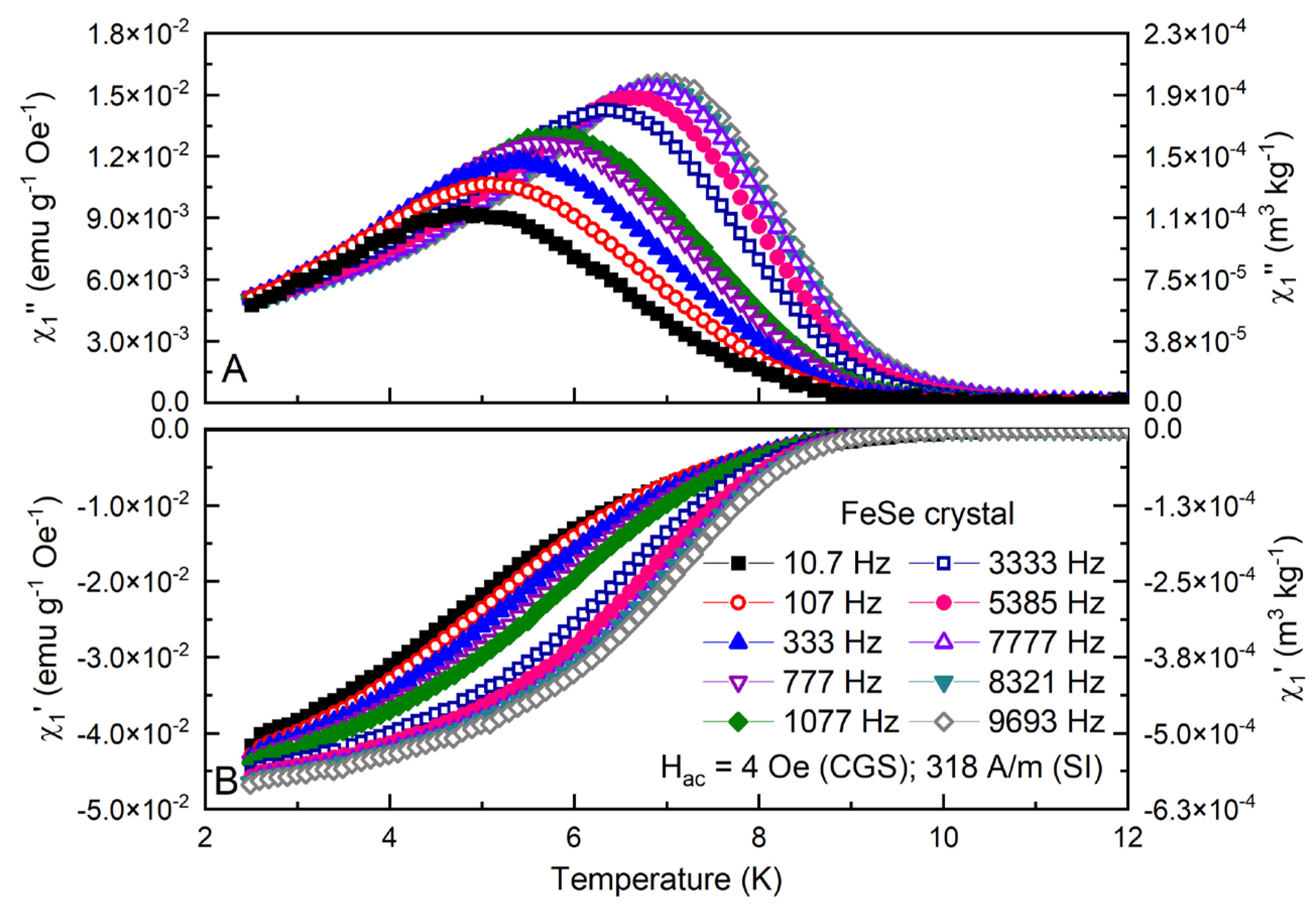
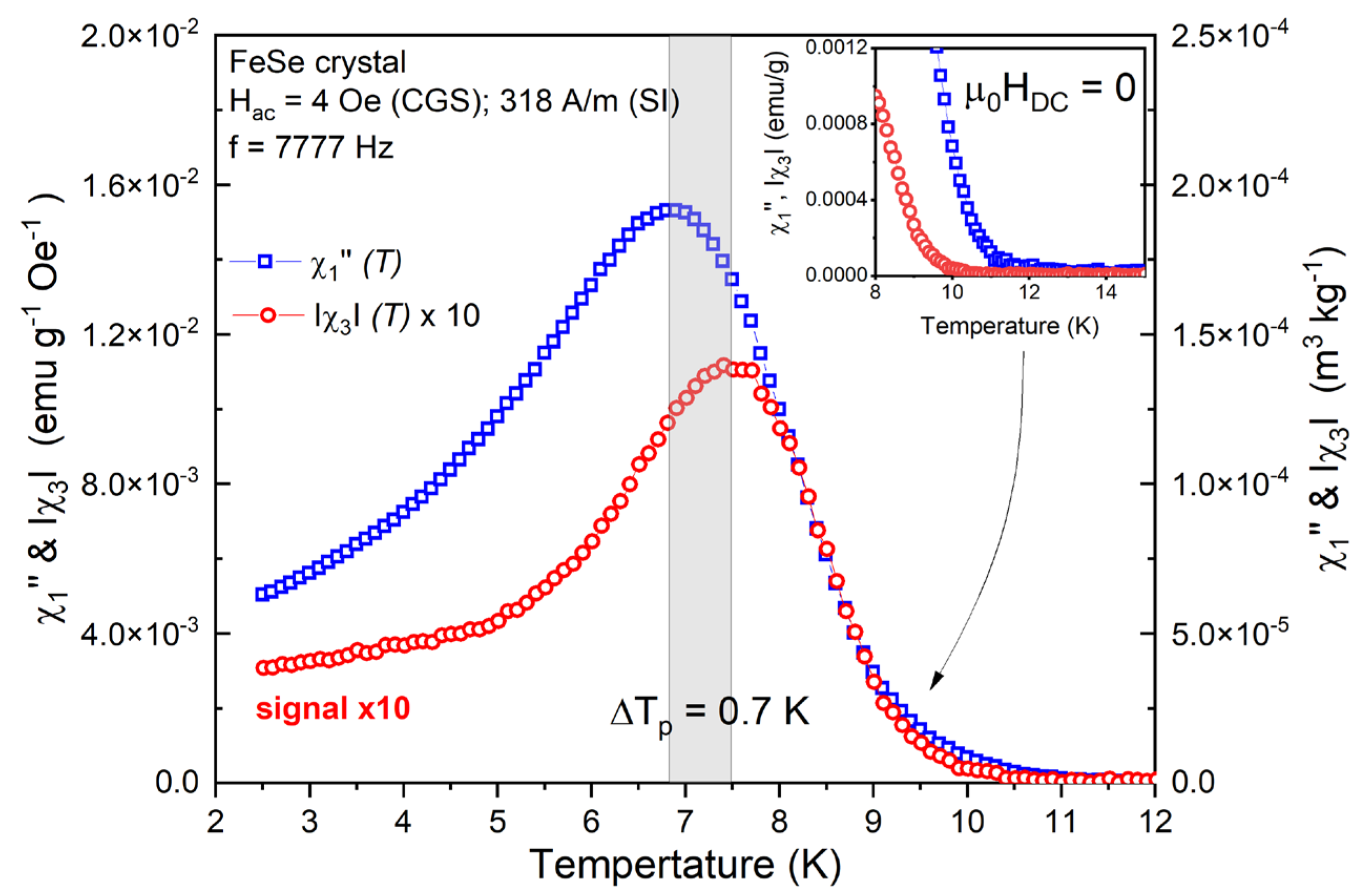
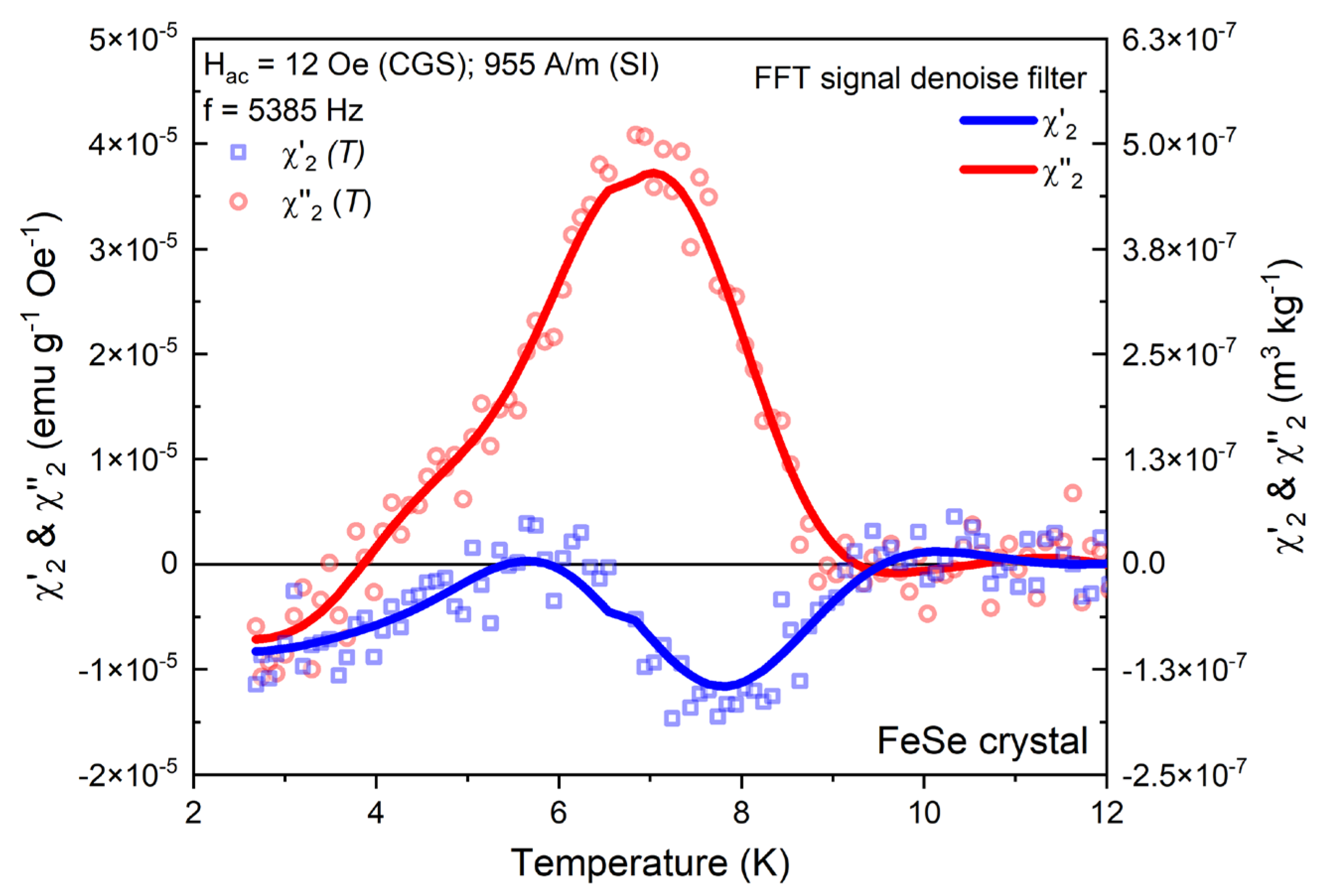
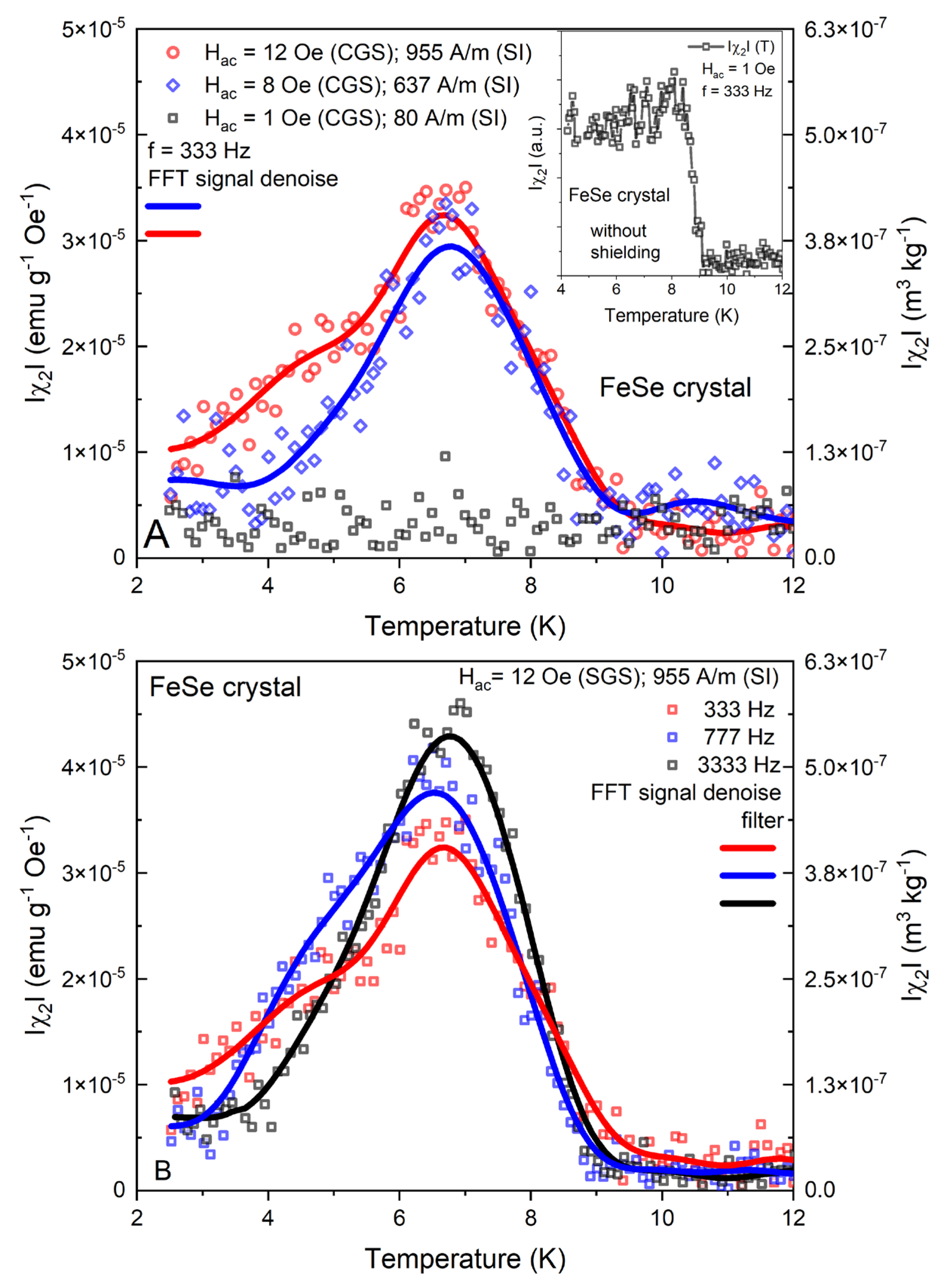
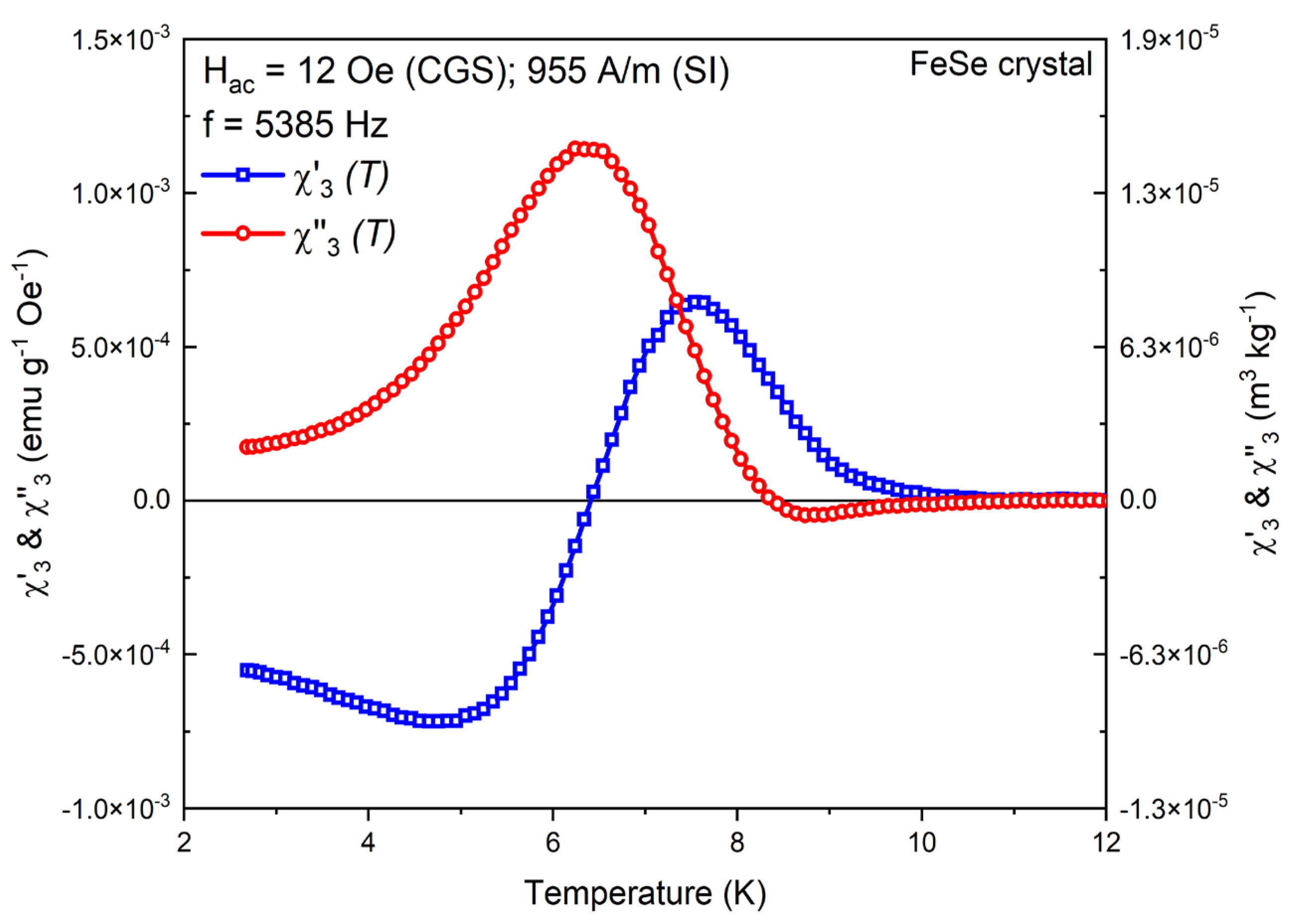
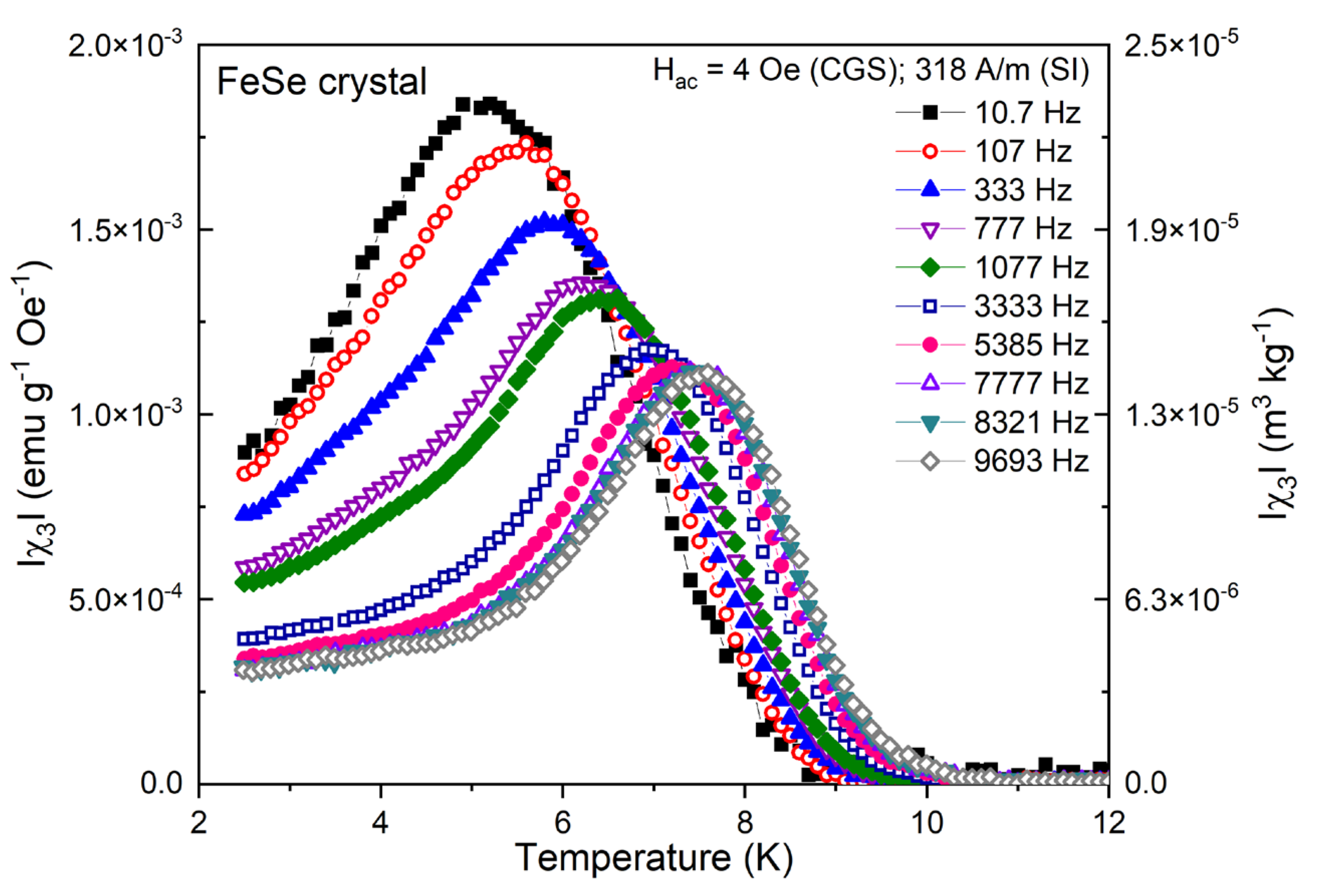


Disclaimer/Publisher’s Note: The statements, opinions and data contained in all publications are solely those of the individual author(s) and contributor(s) and not of MDPI and/or the editor(s). MDPI and/or the editor(s) disclaim responsibility for any injury to people or property resulting from any ideas, methods, instructions or products referred to in the content. |
© 2023 by the authors. Licensee MDPI, Basel, Switzerland. This article is an open access article distributed under the terms and conditions of the Creative Commons Attribution (CC BY) license (https://creativecommons.org/licenses/by/4.0/).
Share and Cite
Buchkov, K.; Galluzzi, A.; Nazarova, E.; Polichetti, M. Complex AC Magnetic Susceptibility as a Tool for Exploring Nonlinear Magnetic Phenomena and Pinning Properties in Superconductors. Materials 2023, 16, 4896. https://doi.org/10.3390/ma16144896
Buchkov K, Galluzzi A, Nazarova E, Polichetti M. Complex AC Magnetic Susceptibility as a Tool for Exploring Nonlinear Magnetic Phenomena and Pinning Properties in Superconductors. Materials. 2023; 16(14):4896. https://doi.org/10.3390/ma16144896
Chicago/Turabian StyleBuchkov, Krastyo, Armando Galluzzi, Elena Nazarova, and Massimiliano Polichetti. 2023. "Complex AC Magnetic Susceptibility as a Tool for Exploring Nonlinear Magnetic Phenomena and Pinning Properties in Superconductors" Materials 16, no. 14: 4896. https://doi.org/10.3390/ma16144896
APA StyleBuchkov, K., Galluzzi, A., Nazarova, E., & Polichetti, M. (2023). Complex AC Magnetic Susceptibility as a Tool for Exploring Nonlinear Magnetic Phenomena and Pinning Properties in Superconductors. Materials, 16(14), 4896. https://doi.org/10.3390/ma16144896








